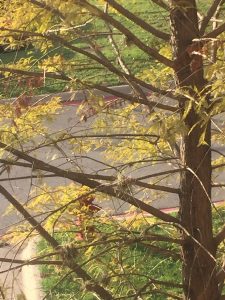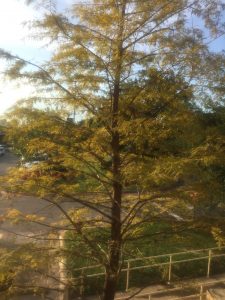Throughout this semester I have been stopping by a location on campus to watch what changes happen here over there. I am able to see this location when looking out from my dorm making it an easy place for me to observe and collect data throughout the semester. The location I choose was the trees outside of my dorm building. I live in Basil Moreau and there is a outdoor courtyard with many different trees and wildlife. I choose to look at the trees on the side of the building closes to my dorm. I chose this location to add in the interesting factor of human envelopment. Over time I have been observing the different organisms that use these trees and what for.
I have identified these trees as an Acacia Farnesiana, a common Texas tree that is identifiable by the clump of multiple trunks growing out of the ground together. I was able to discover this by looking at the bark and leaves and then a guide to the native plants of Austin. It is a fairly thin tree with small brittle leaves. In the spring these trees produce yellow flowers but in the past couple weeks there have been little to no changes with the tree itself
Some background information of my tree is that they were likely planted after the building was built. The tree is located in a place that is populated with people during the day and quiet at night. This effects the animals present here depending on what time I look at it. During the day there are insects on the tree and some squirrels around the bottom. At night, the tree is populated with some birds and also many more animals on the ground below.
Some observations I have made on my location is that the tree has ball moss. Ball moss, also known as Tillandsia Recurvata is a small plant that hosts off of other plants. The ball moss takes the nutrients from the tree without giving the tree anything in return. This tree has a small amount of ball moss that is easily seen attached to the branches. The moss and the tree have a parasitic relationship. When one of the organisms benefits from the relationship but the other doesn’t they are in a parasitic relationship.

I’ve also been watching the animals that are attracted to this tree. There have been multiple different birds and insects on the tree. There are squirrels that stay mostly at the base of the tree on the ground but sometimes go up on the branches. After researching and comparing my pictures, I’ve concluded these squirrels are called eastern gray squirrels. The squirrels are at the base of the tree collecting nuts.The nuts have filled from surrounding trees and the squirrel takes them off the ground to bring them into the trees and crack open. The only time i see squirrels in the tree tops is when they are cracking open the nuts and dropping the shells off of the branches. The insects I have seen include ants crawling on the outside of the bark as well as spider webs in between the leaves and branches of the tree. Some of the spider webs connect multiple branches from different trees. Close to the bottom of the tree, I saw a web with what I researched to possibly be a yellow garden spider.
As mentioned earlier, I observed a noticeable difference from the amount of wild life during the day and at night. This is simply because it is a location where people gather and when the people are there the animals often keep their distance. This doesn’t effect the insects but the mammals like the birds and squirrels.
Bibliography
“Tillandsia Recurvata.” Wikipedia, Wikimedia Foundation, 29 Aug. 2017, en.wikipedia.org/wiki/Tillandsia_recurvata.
Wasowski, S., & Ryan, J. (1985). Landscaping with native Texas plants. Austin, Tex.: Texas Monthly Press.
Wegner, Gerry. (2010). Eastern Gray Squirrel. Pest Management Professional, 78(4), 63.

